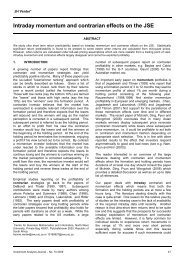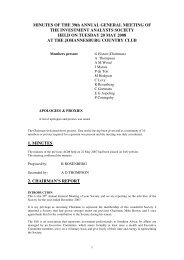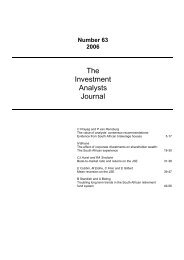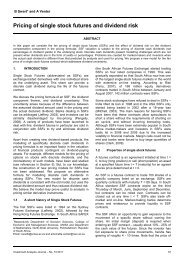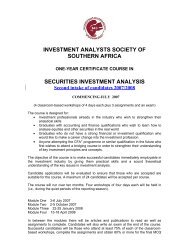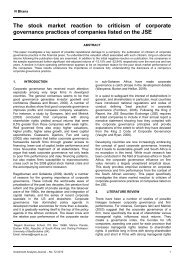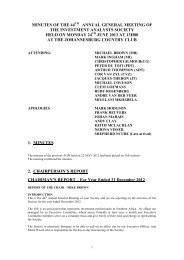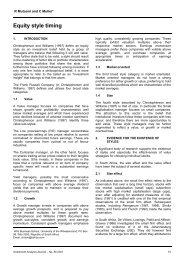Accounting is Broken - Investment Analysts Journal
Accounting is Broken - Investment Analysts Journal
Accounting is Broken - Investment Analysts Journal
Create successful ePaper yourself
Turn your PDF publications into a flip-book with our unique Google optimized e-Paper software.
Stern Stewart & Co.<br />
To continue the example, assume that the business line has no improvement prospects in<br />
the current owner’s hands. Earning a $4 million a year NOPAT <strong>is</strong> the best that can be<br />
expected. In that case the business <strong>is</strong> worth only $40 million to the current owners, which<br />
<strong>is</strong> the result of capitalizing the $4 million a year NOPAT at the 10% cost of capital.<br />
Realizing any value for the unit that <strong>is</strong> greater than $40 million will make share h o l d e r s<br />
better off .<br />
The accounting re p resentation<br />
of the transaction<br />
has succeeded only<br />
in making a wort h w h i l e<br />
dec<strong>is</strong>ion look quite<br />
u n a p p e a l i n g .<br />
Selling it for $75 million, for example, will make the current owners $35 million richer. Ye t ,<br />
by comparing the $75 million sale value with the unit’s $100 million book value, the accountants<br />
will re c o rd a meaningless $25 million book loss on the sale. If the accounting <strong>is</strong> taken<br />
at face value, the apparent impact on EVA <strong>is</strong> to make a ripe dec<strong>is</strong>ion taste sour:<br />
E VA = NOPAT - (WACC% x $Total Capital)<br />
= $ 4 million - ( 10% x $100 million )<br />
- $ 6 million = $ 4 million - $ 10 million<br />
Sale - $ 4 million - $100 million<br />
Loss<br />
- $ 25 million<br />
= - $ 25 million - ( 10% x $ 0 million )<br />
- $25 million = - $ 25 million - $ 0 million<br />
Legitimate accounting <strong>is</strong><br />
always a “double-entry ”<br />
bookkeeping system.<br />
An add-back to “pro -<br />
f o rma” the earn i n g s<br />
must be accompanied by<br />
an add-back to “pro -<br />
f o rma” the balance<br />
s h e e t .<br />
Under current accounting rules, the sale extingu<strong>is</strong>hes the business unit’s $100 million book<br />
value from the firm ’s balance sheet, and it wipes the slate clean on the $4 million a year contribution<br />
to NOPAT. The asset <strong>is</strong> gone, and so are its earnings. The accountants have not<br />
fin<strong>is</strong>hed wiping their sword clean however, as they also slash profit for the $25 million bookkeeping<br />
loss, labeling it a re s t ructuring charge, loss on d<strong>is</strong>position, or some such<br />
euphem<strong>is</strong>tic expre s s i o n .<br />
The accounting re p resentation of the transaction has succeeded only in making a wort h-<br />
while dec<strong>is</strong>ion look quite unappealing. If management has the fortitude to pers<strong>is</strong>t in the sale<br />
of the unit—as they should—the company’s stock price will soar as re p o rted earnings stumble,<br />
but try explaining that to a board of directors much less the average investor. Why<br />
should a dec<strong>is</strong>ion so simple but so valuable be so hard to fathom? Confronted with such<br />
nettlesome obstacles it <strong>is</strong> little wonder that many managers stopped believing accounting<br />
counts what counts, and turned to alternatives.<br />
As the new economy wave took hold in the 1990s many firms d<strong>is</strong>covered they needed to<br />
heave off outmoded assets and outdated business practices with re s t ructuring moves that<br />
often triggered large bookkeeping charges. Business leaders and professional investors<br />
quickly became d<strong>is</strong>enchanted with the auditor’s view of the world. They decided to back<br />
out the re s t ructuring charges and concentrate on new measures with names like core earnings<br />
or pro - f o rma income.<br />
While their hearts were in the right place their minds were not fully in gear. They forg o t<br />
that legitimate accounting <strong>is</strong> always a “double-entry” bookkeeping system. An add-back to<br />
“ p ro - f o rma” the earnings must be accompanied by an add-back to “pro - f o rma” the balance<br />
sheet. In the EVA accounting system, a re s t ructuring charge or divestiture loss <strong>is</strong> added<br />
back to NOPAT, but it <strong>is</strong> also added back to capital, which in the example means that the<br />
$25 million bookkeeping loss must be added back both places:<br />
20




